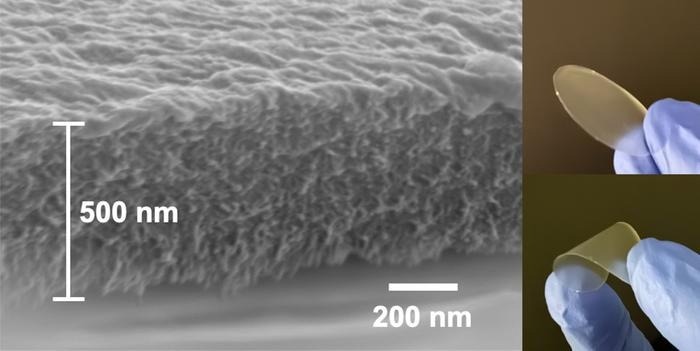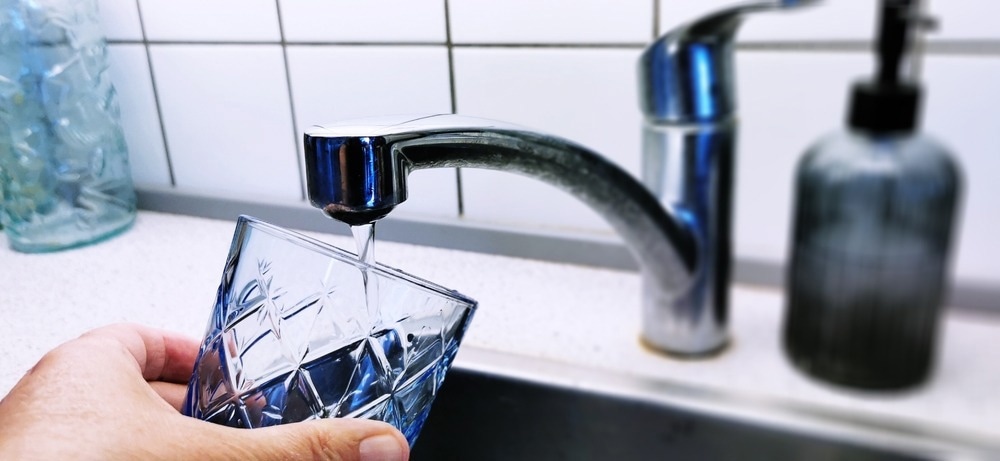Reviewed by Danielle Ellis, B.Sc.Sep 6 2024
Water contamination from chemicals used in modern technology is an increasingly serious global issue. A recent study by the US Centers for Disease Control revealed that 98% of individuals tested had detectable levels of PFAS, a group of highly persistent compounds known as "forever chemicals," in their bloodstream.

By integrating cellulose into the silk-based fibrils that could be formed into a thin membrane, and then tuning the electrical charge of the cellulose, the researchers produced a material that was highly effective at removing contaminants in lab tests. Pictured is an example of the filter. Image Credit: Courtesy of Yilin Zhang and Benedetto Marelli
A novel filtration material created by MIT researchers may offer a natural remedy for this nagging contamination problem. The material, which is based on cellulose and natural silk, can eliminate heavy metals and a wide range of persistent chemicals. Furthermore, its antimicrobial qualities may prevent filter fouling.
The study authors include MIT postdoc Yilin Zhang, Professor Benedetto Marelli of civil and environmental engineering, and four other MIT members. The study has been published in the journal ACS Nano.
Cosmetics, food packaging, water-resistant apparel, firefighting foams, and cookware with an antistick coating are just a few of the products that contain PFAS chemicals. In the United States alone, 57,000 sites have been linked to these chemicals. According to estimates from the US Environmental Protection Agency, PFAS remediation will require an annual budget of $1.5 billion to comply with new regulations that limit the compound to less than seven parts per trillion in drinking water.

Image Credit: P. Qvist/Shutterstock.com
Contamination by PFAS and similar compounds “is actually a very big deal, and current solutions may only partially resolve this problem very efficiently or economically. That’s why we came up with this protein and cellulose-based, fully natural solution,” said Zhang.
We came to the project by chance.
Benedetto Marelli, Professor, Department of Civil and Environmental Engineering, Massachusetts Institute of Technology
The underlying technology that enabled the filtration material was originally created by his team for a totally unrelated use: creating a labeling system to stop the spread of fake seeds, which are frequently of lower quality. His group developed a room-temperature, environmentally safe drop-casting technique for silk proteins that yield homogenous nanoscale crystals, or "nanofibrils."
Although initial attempts using the silk nanofibrils alone failed, Zhang suggested that their new nanofibrillar material might be useful for filtering contaminants. The group made the decision to attempt incorporating cellulose, which is widely accessible and can be made from the waste wood pulp from farms. The silk fibroin protein is suspended in water and then templated into nanofibrils by introducing "seeds" of cellulose nanocrystals, according to the researchers' self-assembly technique. As a result, the previously disorganized silk molecules align along the seeds, creating the framework for a hybrid material with unique new characteristics.
Through the incorporation of cellulose into silk-based fibrils, which could be shaped into a thin membrane, and subsequent manipulation of the cellulose's electrical charge, the scientists generated a material that demonstrated exceptional efficacy in eliminating pollutants in laboratory experiments.
The team discovered that the cellulose's strong antibacterial qualities were also a result of its electrical charge. This is a big benefit because bacterial and fungal fouling is one of the main reasons filtration membranes fail. According to the researchers, this material's antimicrobial qualities should significantly lessen the fouling problem.
These materials can really compete with the current standard materials in water filtration when it comes to extracting metal ions and these emerging contaminants, and they can also outperform some of them currently.
Benedetto Marelli, Professor, Department of Civil and Environmental Engineering, Massachusetts Institute of Technology
In laboratory experiments, the materials were able to remove orders of magnitude more pollutants from water than the activated carbon or granular activated carbon that is currently the industry standard.
According to Marelli, the team intends to keep working on enhancing the material, particularly in terms of its durability and source material availability, even though the current work acts as a proof of concept. Although the silk proteins that are used can be obtained as a byproduct of the silk textile industry, there may not be an adequate supply if this material were to be scaled up to meet the world's needs for water filtration. Additionally, it is possible that less expensive alternatives to protein materials can accomplish the same task.
According to Zhang, the material would first probably be utilized as a point-of-use filter that could be fastened to a kitchen faucet. It might eventually be expanded to filter municipal water supplies, but only after testing shows there would be no danger of contaminating the water supply in the process. However, Zhang points out that one significant benefit of the material is that the cellulose and silk ingredients are both regarded as food-grade materials, making contamination unlikely.
Most of the normal materials available today are focusing on one class of contaminants or solving single problems. I think we are among the first to address all of these simultaneously.
Yilin Zhang, Postdoc, Department of Civil and Environmental Engineering, Massachusetts Institute of Technology
Yunteng Cao, Ph.D., a recent Graduate who is currently a postdoc at Yale, Graduate Student Maxwell Kalinowski, and postdocs Hui Sun and Meng Li from MIT were also members of the research team. The Singapore-MIT Alliance for Research and Technology, the National Science Foundation, and the Office of Naval Research all provided funding for the project.
Journal Reference:
Zhang, Y., et al. (2024) Directed Assembly of Proteinaceous–Polysaccharide Nanofibrils to Fabricate Membranes for Emerging Contaminant Remediation. American Chemical Society. doi/10.1021/acsnano.4c07409